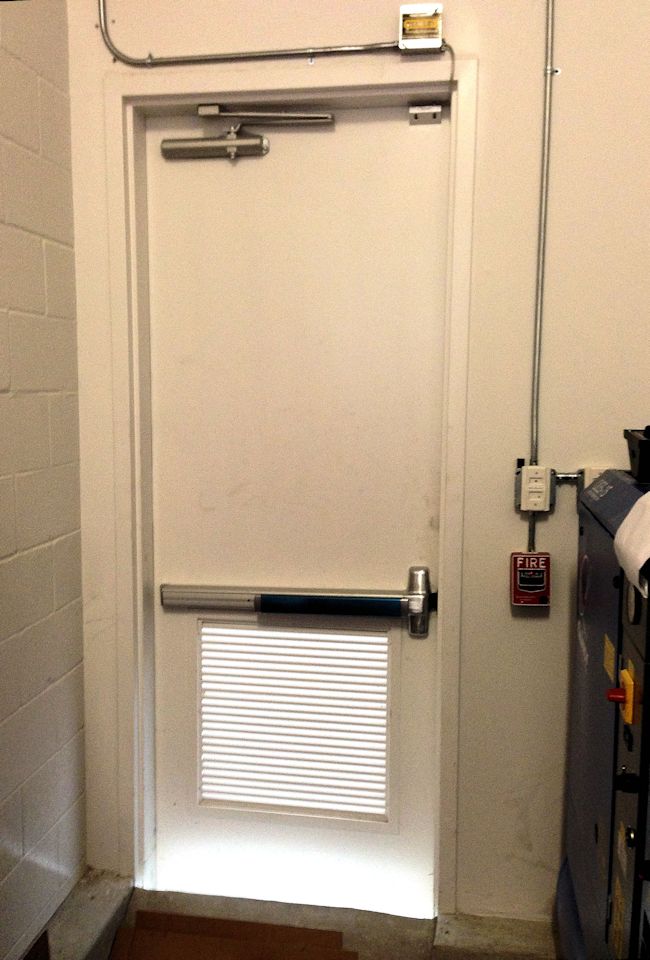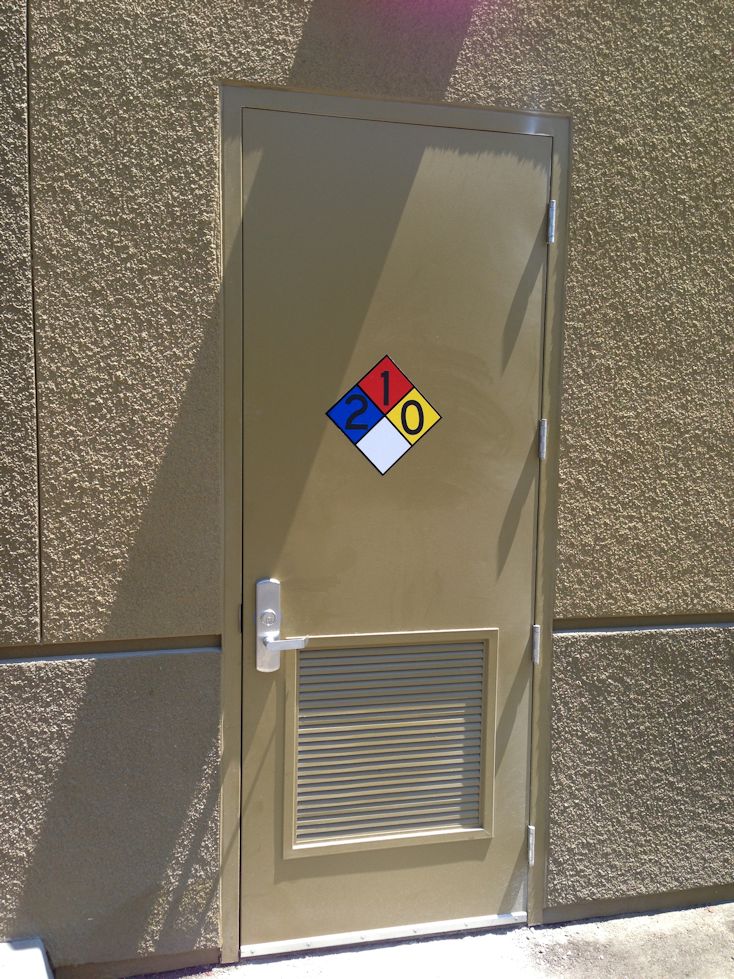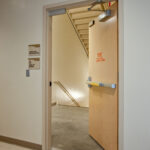I have updated this Decoded article to include current requirements from the 2023 edition of NFPA 70, in addition to previous editions beginning with the 2002 National Electrical Code.
This post was published in Doors & Hardware

 Many codes and standards are updated on a 3-year cycle and then adopted by the jurisdictions at a later date; this makes it difficult to keep up with which requirements apply to a particular project at a specific point in time. Staying current on the codes is further complicated by the fact that there are dozens of codes and standards that may include requirements related to doors and hardware. It’s even more confusing when adopted codes and referenced standards contain inconsistent requirements, typically with one set more stringent than the other.
Many codes and standards are updated on a 3-year cycle and then adopted by the jurisdictions at a later date; this makes it difficult to keep up with which requirements apply to a particular project at a specific point in time. Staying current on the codes is further complicated by the fact that there are dozens of codes and standards that may include requirements related to doors and hardware. It’s even more confusing when adopted codes and referenced standards contain inconsistent requirements, typically with one set more stringent than the other.
NFPA 70 – National Electrical Code (NEC) has been adopted by most US states, and includes requirements for panic hardware or fire exit hardware on certain rooms housing electrical equipment. The International Building Code (IBC) also includes a paragraph addressing panic hardware on electrical rooms, but since the NFPA 70 requirements are more restrictive, these doors must typically comply with the NEC. It’s important to know which edition of the NEC applies to the project in question, as the panic hardware requirements have changed several times over the last 20+ years.
The 2002 edition of NFPA 70 was the first edition to include a requirement for some electrical rooms to have doors that open in the direction of egress and to be “equipped with panic bars, pressure plates, or other devices that are normally latched but open under simple pressure.” This change was motivated by injuries and even fatalities caused by accidents within rooms housing electrical equipment, which left the technicians unable to open the door to escape.
 The original terminology used to describe the hardware for some electrical room doors was not very specific, leaving it open to interpretation. “Simple pressure” would typically be an operation in the direction of egress to release the latch, rather than turning a knob or lever. By this definition, a hospital latch or paddle-type release could be considered devices that are normally latched but open under simple pressure, but because the words “panic bar” were used, many code officials interpreted the requirement as mandating panic hardware.
The original terminology used to describe the hardware for some electrical room doors was not very specific, leaving it open to interpretation. “Simple pressure” would typically be an operation in the direction of egress to release the latch, rather than turning a knob or lever. By this definition, a hospital latch or paddle-type release could be considered devices that are normally latched but open under simple pressure, but because the words “panic bar” were used, many code officials interpreted the requirement as mandating panic hardware.
The 2002 edition (Article 110) requires hardware that operates with simple pressure for rooms housing equipment with more than 1200 amperes (amps) or more than 600 volts, and for transformer vaults. In the 2005 edition, a slight change was made with regard to room size requirements, and the 2008 edition added language that would require this hardware if the door was within 25 feet of the nearest edge of the required working space around the electrical equipment. The 2011 edition added some specifics for electrical vaults, including a requirement for a 3-hour-rated fire door, with the same description of the hardware – panic bars, pressure plates, or other devices that are normally latched but open under simple pressure.
In the 2014 edition of the NEC, several sections were changed to require “listed panic hardware” instead of devices that open under simple pressure. Listed panic hardware is listed to UL 305 – Standard for Panic Hardware.
This edition also changed the voltage and amperage limits that mandate panic hardware on rooms housing such equipment. Personnel doors within 25 feet of the working space and intended for entrance and egress are required by the 2014 edition of NFPA 70 to have listed panic hardware:
- Where equipment is 800 amps or more and contains overcurrent devices, switching devices, or control devices (Section 110.26 (C) (3)),
- Where equipment is 600 volts or more (Section 110.33 (A) (3)), and
- On doors serving battery rooms (Section 480.9 (E)).
The sections of the 2014 edition that address electrical vaults (Section 110.31 (A)), transformer vaults (Section 450.43 (C)), and modular data centers (Section 646.19) still included the vague language: “Personnel doors shall swing out and be equipped with panic bars, pressure plates, or other devices that are normally latched but that open under simple pressure.”
The 2017 edition of NFPA 70 changed these requirements once again. In jurisdictions where the 2017 edition is adopted, personnel doors intended for entrance/egress, less than 25 feet from the nearest edge of the working space, must be outswinging and equipped with listed panic hardware when serving the following rooms:
- Rooms housing equipment of 1000 volts, nominal, or less, with equipment rated 800 amps or more that contains overcurrent devices, switching devices, or control devices (Section 110.26 (C) (3))
- Rooms housing equipment of more than 1000 volts, nominal (Section 110.33 (A) (3))
- Transformer Vaults (Section 450.43 (C))
- Battery Rooms (Section 480.10 (E))
- Energy Storage Systems (ESS Rooms) (Section 706.10 (D))
Section 646.19 addresses personnel doors serving modular data centers. If the equipment is more than 6 feet wide or 6 feet deep, there must be a door at each end of the working space, providing entrance to and egress from the required working space. The door must be at least 24 inches wide and 78 inches high, and must be outswinging and equipped with panic bars, pressure plates, or other devices that are normally latched but open under simple pressure. Refer to the NEC for an exception that would allow one door instead of two if certain criteria are met.
In the 2020 edition of NFPA 70, the requirements changed slightly:
- Rooms housing equipment of 1000 volts, nominal, or less, with equipment rated 800 amps or more that contains overcurrent devices, switching devices, or control devices (Section 110.26 (C) (3))
- Electrical vaults (Section 110.31 (A) (4)) and rooms housing equipment of more than 1000 volts, nominal (Section 110.33 (A) (3))
- Transformer Vaults (Section 450.43 (C))
- Battery Rooms (Section 480.10 (E))
- Modular Data Centers (Section 646.19)
The 2023 edition of the code did not include changes to the types of rooms/equipment that require doors with panic hardware or fire exit hardware, but a change was made to specify that personnel doors serving these rooms must open at least 90 degrees.
In addition to the egress requirements, doors to some rooms housing electrical equipment are required by NFPA 70 to be equipped with locking hardware and kept locked on the outside, allowing access only to authorized people. In order to specify, supply, and/or install panic hardware on the proper doors, verify which edition of the National Electrical Code applies to the project, and then refer to that edition for the specifics. There are still a couple of FAQs which are not addressed by the NEC. One is whether panic hardware is required on one leaf of a pair of doors serving these rooms, or both leaves of the pair. Another question is in reference to “extra doors” that are not required by code but may be used by technicians. I tend to go with panic hardware on both leaves of the pair and also on the extra doors to avoid problems in the field, but the Authority Having Jurisdiction (AHJ) should be consulted for the official answer.
Note: The 2021 edition of the IBC has added a requirement for panic hardware on doors serving refrigeration machinery rooms. For more information, refer to this code update post.
Thank you to Nathan Burkhardt of Opening Technologies for the photos!
You need to login or register to bookmark/favorite this content.









What if the room housing the electrical equipment is accessed through another door(s). For example: an apartment building with a common laundry room before the electrical room, so someone walked through the laundry room to get to the electrical room. Do all doors in the path need to be furnished with panic hardware, or just the door that leads directly to the electrical room?
Hi Roye –
The way I understand the NEC, it would apply to any door within 25 feet of the required working space around the electrical equipment. So if there is a second (or third…) door within that distance, it would need panic hardware if the door had a lock or latch.
– Lori
Hi Lori,
Thank you for compiling this thorough list. I have cobbled (due to its constant changes) this code subject together for years but it is nice to have it all in a single article I can share with end users.
I reviewed the 2020 edition Battery Rooms (Section 480.10), and don’t see a requirement for minimum size (amps or volts) regarding what is considered a battery room, maybe this will be covered in a future edition.
Hi Matthew –
I’m glad this article is helpful…it was not an easy one since I don’t spend much time in the NEC. I’ll see what I can find out about battery rooms.
– Lori
Hi Lori,
Can you please help me understand the 25′ working space requirement? Is this indicating 25′ from the panel location to the door, or is it an indication of room dimension?
Hi Danielle –
The National Electrical Code requires a certain amount of working space around electrical equipment, depending on the voltage (and maybe other factors – I don’t know). So imagine that a piece of equipment is required to have a 3-foot x 3-foot clear space in front of it – any door that is within 25 feet of the outside edge of that required working space would need panic hardware if panic hardware is required for that room.
– Lori